Ethiopia
All Destinations
Ethiopia
Ethiopia is all about its people, its history and traditions, and its breathtaking scenery. As one of the oldest nations in the world, and home to the second largest nation of people in Africa, Ethiopia is an excellent country from which to gain real insight into African history and culture.
It is the only country in Africa never to have been fully colonised (with the exception of a five-year occupation by Mussolini’s Italy), and in the 20th century was dominated by the figure of Haile Selassie, who became emperor in 1930 and ruled until the military coup of 1974.
Left alone by mass tourism, Ethiopia boasts the largest number of UNESCO sites in Africa. The ancient holy city and royal capital of Aksum (or Axum), the earliest Ethiopian kingdom, lies in the north of the country. It is renowned for its multi-storied carved granite obelisks, for important archaeological remains and for the church which claims to house the Lost Ark of the Covenant.
Gondar. the ‘Camelot of Africa’, was the capital of Ethiopia from 1632 to 1855 and is the site of a number of ruined castles and is famed for its beautiful examples of Ethiopian church art; and then there is Lalibela, one of the world’s most astounding sacred sites, famous for its 12th century, rock-hewn churches, quite remarkable and essential visiting.
For the more vigorous, the Simien mountains, Africa’s most rugged, provide excellent trekking opportunities with dramatic skylines, unique wildlife and rich grassy plateaux. The Blue Nile rises south of the Simiens, and boat trips to the source navigate around wallowing hippos and vast flocks of pelicans. For animal lovers, the southern reserves boast lions, elephants, giraffes, leopards and buffalo – although hunting has severely reduced numbers – but there remain reasonably healthy populations of several varieties of gazelle and antelope; and with over 850 known species – 30 endemic – Ethiopia is a migratory destination for birdwatchers as well as birds.
Quick Facts
Capital
Addis Ababa, 102.5 million
Population
102.4 million
Area
1.13 million sq km (437,794 sq miles)
Major Languages
Amharic, Oromo, Tigrinya, Somali
Major religion
Christianity, Islam
Monetary Unit
Birr
Flight time from London
7.5 hours
Time Difference
GMT + 3
When to go
Ethiopia’s climate is typically very mild.
The highlands, covering most of the country, experience a pleasant year-round average of 16C, the elevation ensuring even summer highs are a balmy 25C.
The lowlands are hot, tipping 40C. Nights are cold and at higher altitudes jumpers are needed..
The heaviest rains traditionally fall June to early October, making the rest of the year a prime time to visit. Directly after the rains the highlands are wonderfully green, covered with wildflowers and sublime for trekking.
- J
- F
- M
- A
- M
- J
- J
- A
- S
- O
- N
- D
- High Season
- Mid Season
- Shoulder Season
Highlights
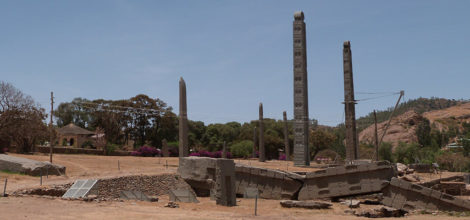
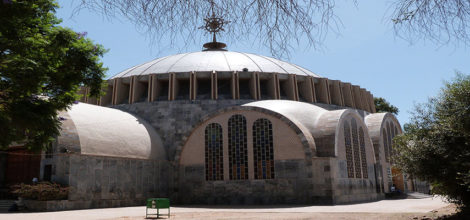
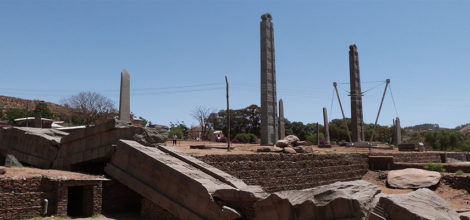


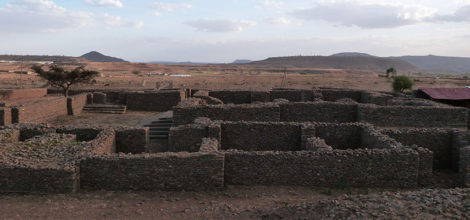
Axum
There is evidence of a once great civilisation here. By the 1st Century AD, Axum was known by the traders of Greece as a great and fine city, and the political and religious centre of the Axumite Empire, which dominated the trade routes between Asia and Africa for nearly a thousand years. Axum is the location of the Church of St Mary of Zion, where the Ark of the Covenant is said to have been placed by Menelik, son of King Solomon, 3000 years ago; a connection with the legendary Queen of Sheba.
Despite the decline of the Axumite Empire in the 7th Century AD, following the rise of Islam and the closure of trade routes to Asia, Axum continued to be a centre of Ethiopian power. The rich history of Axum can be found all around, in its monuments, the giant, carved stellae, and the ruins of palaces and royal graves.
The huge granite stellae in the Park of the Stellae are the most famous feature of Axum. Originally seven in number, the largest of these stellae measured thirty-three metres (79 feet) and weighed about 500 tons, but it fell centuries ago and lies in pieces next to the remaining stellae. The second largest (24m, 79ft) fell earlier this century, and was taken to Rome in 1937. The third largest (23m, 75ft) still stands in Axum.
All the stellae share the same decoration, in the form of a house, many storeys up, with representations of doors and windows.
The biggest mystery of Axum is the claim that it is the last resting place of the Ark of the Covenant. According to Ethiopian legend, Menelik brought the Ark here 3000 years ago and founded the Solomonic Dynasty, of which Haile Selassie was the last emperor. The chapel sanctuary of the ark is well guarded, and visitors can approach but not enter. However, during the Festival of Timkat (Epiphany), a replica of the ark is carried in a procession to the nearby Queen of Sheba’s Baths, a huge water reservoir, carved into solid rock.
The Queen of Sheba also had a palace here, the remains of which can be seen just outside of town, and across the road from this stand more stelae, though smaller than the ones in the Park of the Stellae. These are mostly undecorated, but one, decorated with four horizontal bands topped by rows of circles, is said to mark the Queen of Sheba’s grave.

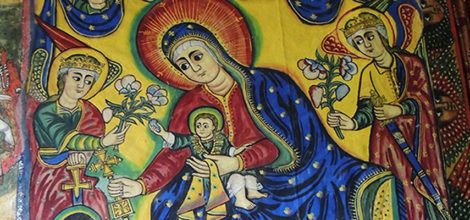

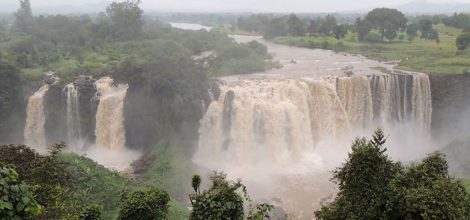
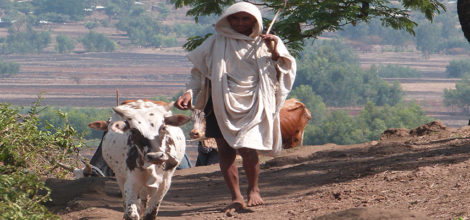
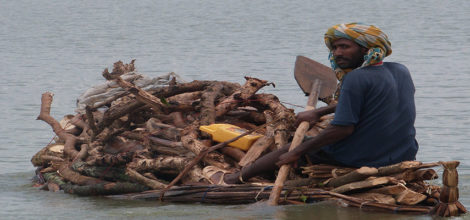
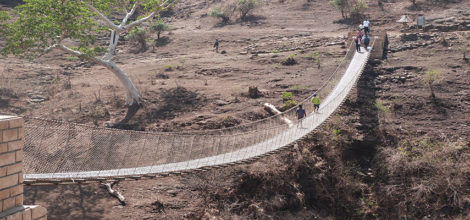
Bahir Dar
There are secluded Island monasteries on Lake Tana with ecclesiastical treasures hinting at a mysterious past. These include Dek Stephanos with its priceless collections of icons, and the remains of several medieval emperors, and Kebran Gabriel and Ura Kidane Mehret with its famous frescoes. The colourful local market at Bahir Dar is renowned for its weavers and wood workers.
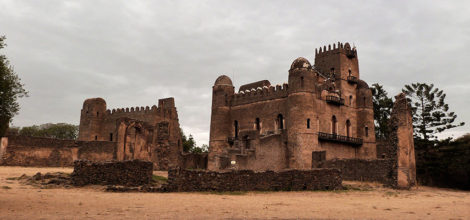
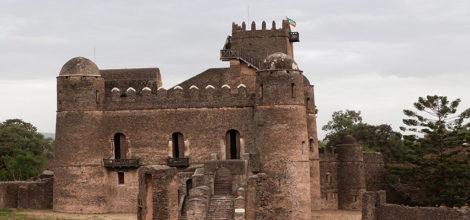
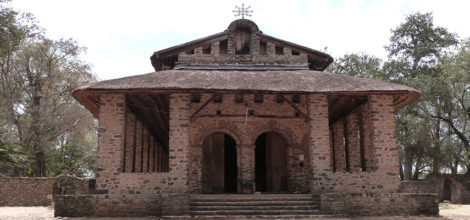

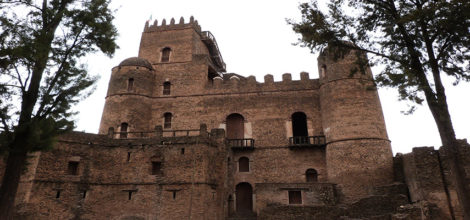

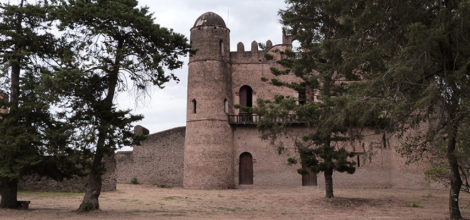

Gondar
Gondar became the capital of Ethiopia during the reign of Emperor Fasiladas (1632-1667), who built the first of the many castles to be found here. During this time, Gondar rose to prominence as Ethiopias largest permanently settled city. Gondar was a thriving centre of theology, trade, craftsmanship and the arts, and an sophisticated administrative and aristocratic centre. In the 19th Century, Emperor Tewodros II moved his government to Debre Tabor and then Mekdala, and Gondar became less important, eventually looted by the Sudanese Dervishes in the 1880s. The city contains some of Ethiopia’s most fascinating antiquitites.
Many structures can be found in the Imperial compound. The two-storeyed Palace of Emperor Fasiladas comprises a flat roofed structure, with four small round towers, a battlement parapet and a large tower, from which Lake Tana can be seen in the distance. Here, you can also find the Palace of Fasiladas’ son, Emperor Yohannes I (1667-1682), the Palace of Yohannes’ son, Emperor Iyasu I (1682-1706), the large hall of Emperor Dawit II (1716-1721) ,the banqueting hall of Emperor Bakaffa (1722-1730) and the palace of his Empress, Mentewab.
South of Gondar, you can find the bathing palace of Fasiladas, which is filled with water once a year for the Timkat (Epiphany) ceremony. To the North-West, are buildings belonging to the government of the time, most of which are now ruins. The largest of these is a three-storeyed castle, the battlement parapets embellished with bas reliefs of Ethiopian animals. There are also many churches here, including Debre Birhan Selassie, the roof of which is decorated with winged angels, and the walls with biblical depictions, including the crucifixion, and the legend of St George and the Dragon. The churches of Gondar contain ancient Gondarine manuscripts, and a crypt holds the skeletal remains of Empress Mentewab her son, Emperor Iyasu II, and her grandson Emperor Iyo’as.
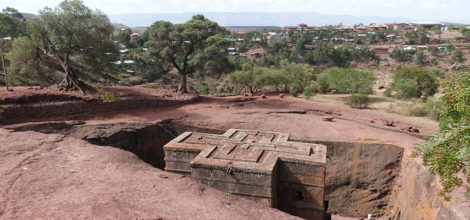
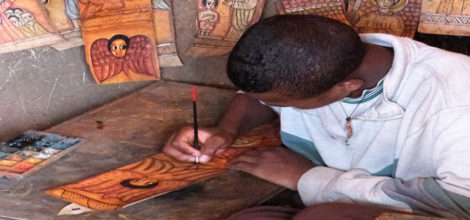
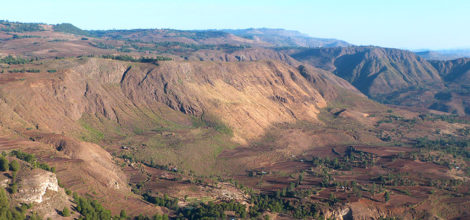
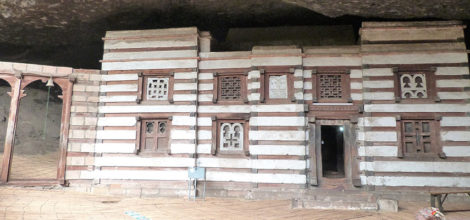
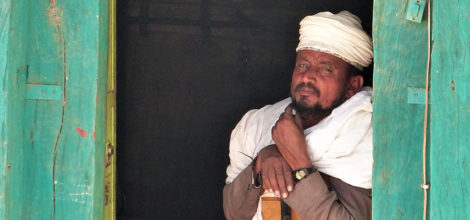

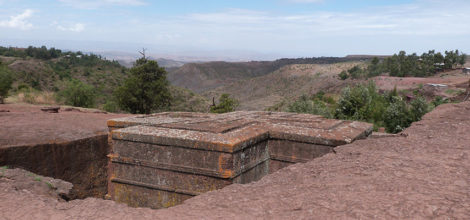

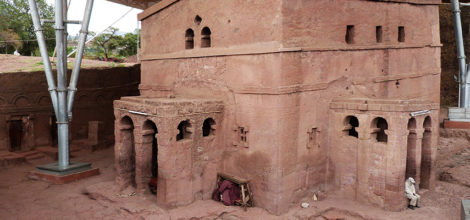
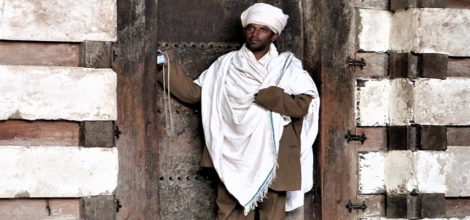
Lalibela
Lalibela, formerly called Roha, now carries the name of the 11th Century King Lalibela of the Zagwe Dynasty. Legend tells of rivalry between the young Prince Lalibela and his elder brother, King Harbay, following their mother’s revelation that Lalibela would be King. Harbay attempted to murder Lalibela with a poison which put Lalibela to sleep. During this sleep, Lalibela was taken to Heaven by angels, where God ordered him to build churches in Roha. Awakening from his sleep, and forgiving his brother, the two travelled to Roha, where Harbay abdicated to make way for Lalibela. On his coronation, Lalibela set about building the churches, the work being completed quickly because angels were said to continue the work at night.
The churches are carved from the rock they stand in, and many are comprised of labyrinthine tunnels and crypts connecting galleries and grottos. The largest church is Bet Medhane Alem, built almost like a Greek temple, surrounded by square columns, and a further set of columns supporting the roof inside. In one corner are three symbolic graves, dug for biblical patriachs Abraham, Issac and Jacob.
The two churches of Bet Golgotha and Bet Mika’el are complexly interlinked, and house the Selassie Chapel, and perhaps even the tomb of Lalibela himself. The churches also house some of the most beautiful processional crosses in Lalibela, one of the most elaborate and oldest of which is reputed to have belonged to Lalibela.
The elegant, Greek cross-shaped church of Bet Giyorgis is located in a deep pit with perpendicular walls, accessible only by a tunnel located a small distance away. This church was built by Lalibela for Saint George, who is said to have supervised its construction himself, and the monks will still show you the hoof marks left by his horse.
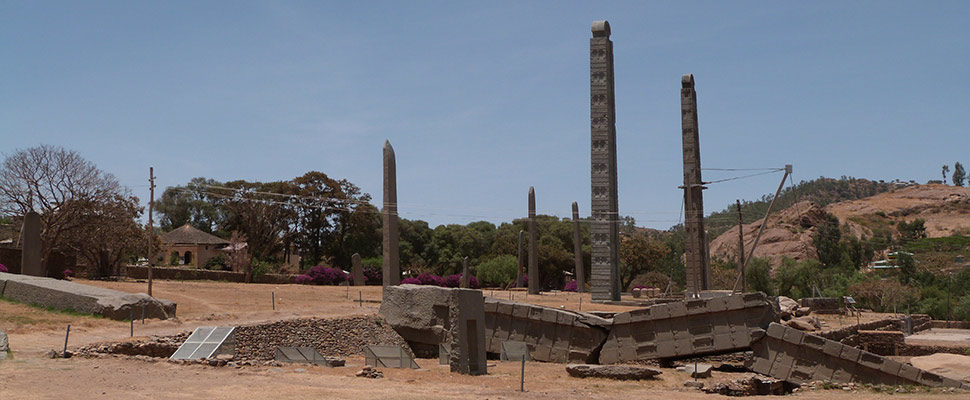
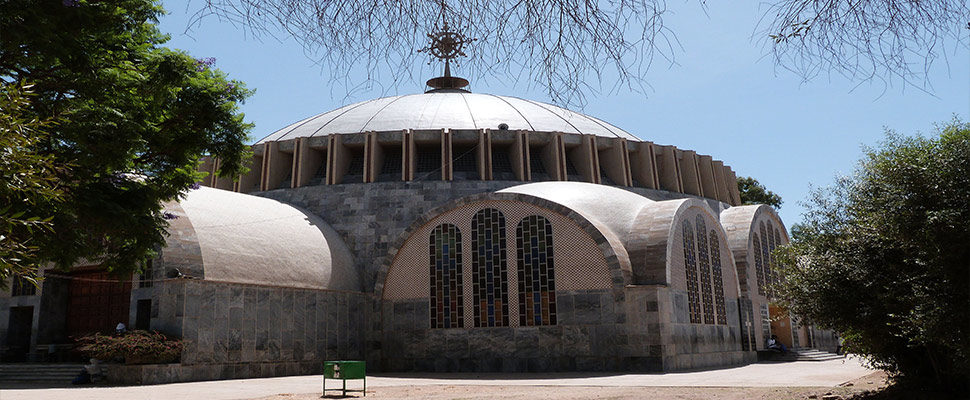
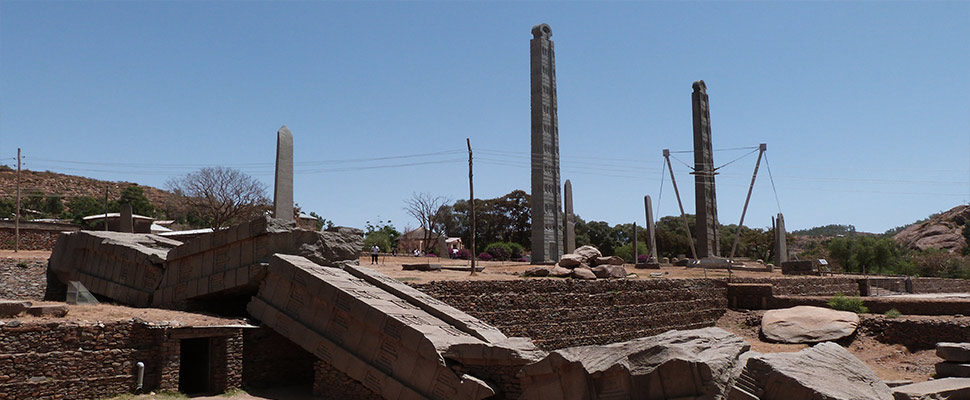
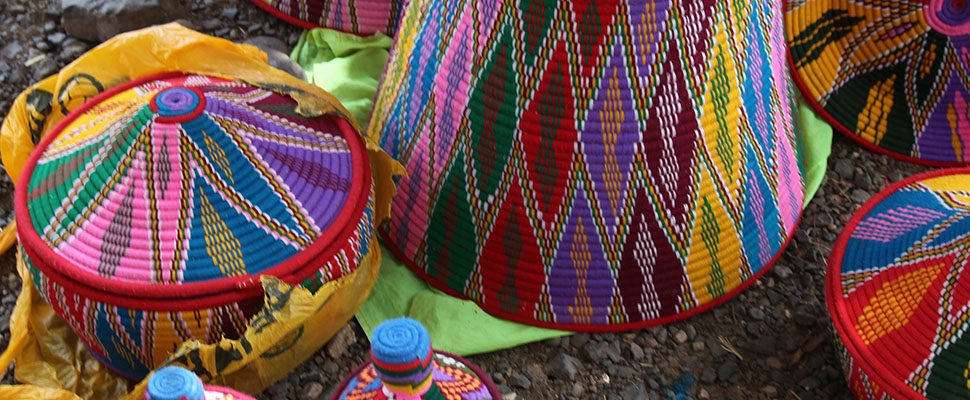
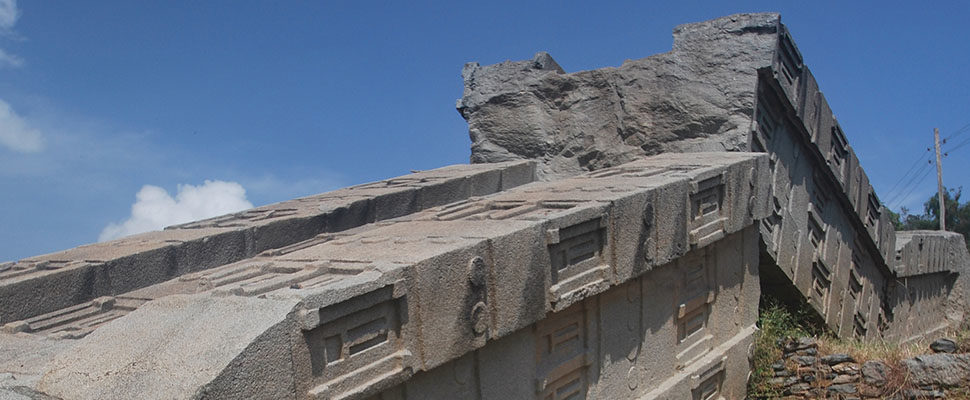

Axum
There is evidence of a once great civilisation here. By the 1st Century AD, Axum was known by the traders of Greece as a great and fine city, and the political and religious centre of the Axumite Empire, which dominated the trade routes between Asia and Africa for nearly a thousand years. Axum is the location of the Church of St Mary of Zion, where the Ark of the Covenant is said to have been placed by Menelik, son of King Solomon, 3000 years ago; a connection with the legendary Queen of Sheba.
Despite the decline of the Axumite Empire in the 7th Century AD, following the rise of Islam and the closure of trade routes to Asia, Axum continued to be a centre of Ethiopian power. The rich history of Axum can be found all around, in its monuments, the giant, carved stellae, and the ruins of palaces and royal graves.
The huge granite stellae in the Park of the Stellae are the most famous feature of Axum. Originally seven in number, the largest of these stellae measured thirty-three metres (79 feet) and weighed about 500 tons, but it fell centuries ago and lies in pieces next to the remaining stellae. The second largest (24m, 79ft) fell earlier this century, and was taken to Rome in 1937. The third largest (23m, 75ft) still stands in Axum.
All the stellae share the same decoration, in the form of a house, many storeys up, with representations of doors and windows.
The biggest mystery of Axum is the claim that it is the last resting place of the Ark of the Covenant. According to Ethiopian legend, Menelik brought the Ark here 3000 years ago and founded the Solomonic Dynasty, of which Haile Selassie was the last emperor. The chapel sanctuary of the ark is well guarded, and visitors can approach but not enter. However, during the Festival of Timkat (Epiphany), a replica of the ark is carried in a procession to the nearby Queen of Sheba’s Baths, a huge water reservoir, carved into solid rock.
The Queen of Sheba also had a palace here, the remains of which can be seen just outside of town, and across the road from this stand more stelae, though smaller than the ones in the Park of the Stellae. These are mostly undecorated, but one, decorated with four horizontal bands topped by rows of circles, is said to mark the Queen of Sheba’s grave.

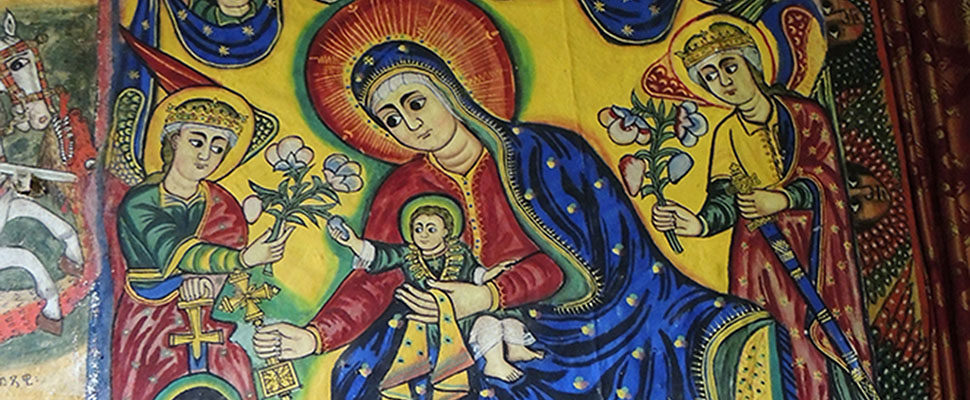
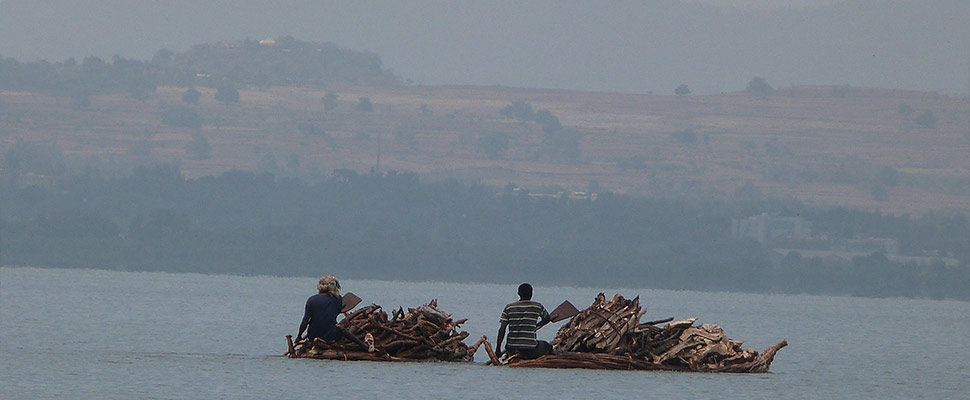
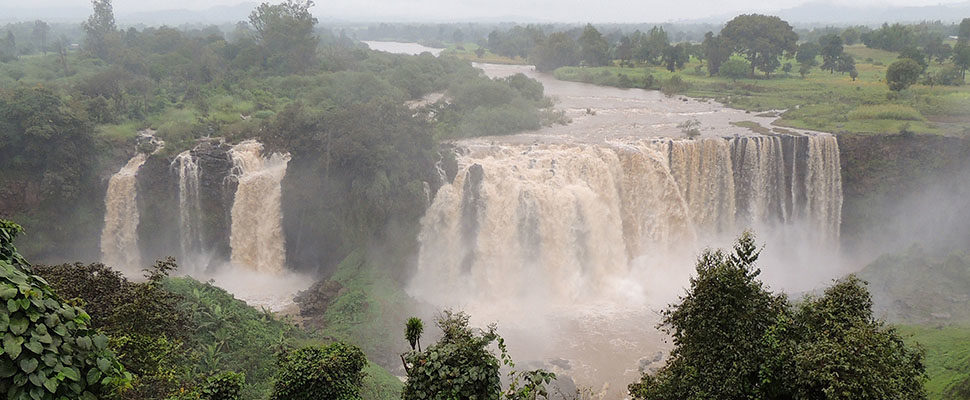
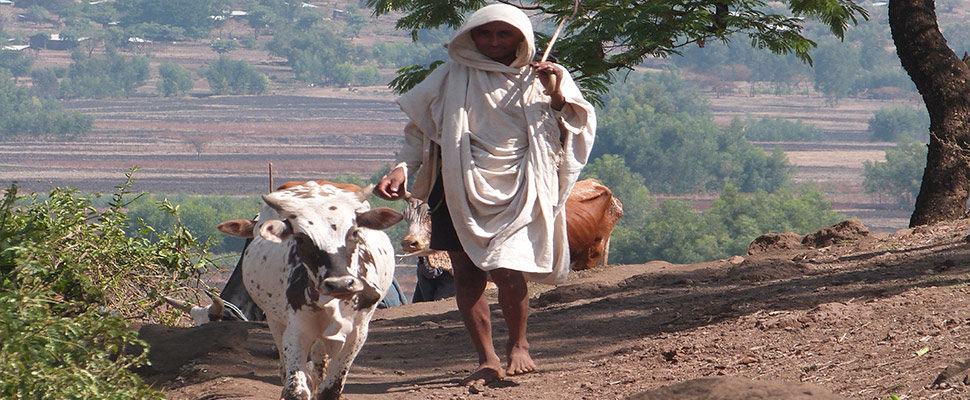
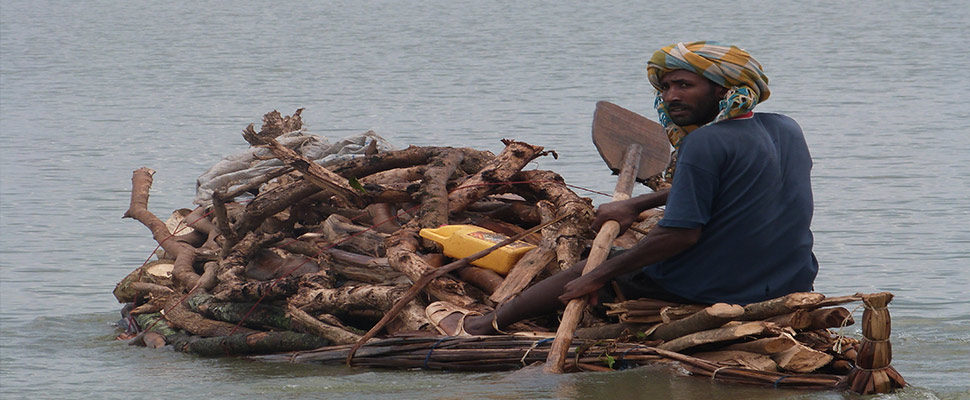

Bahir Dar
There are secluded Island monasteries on Lake Tana with ecclesiastical treasures hinting at a mysterious past. These include Dek Stephanos with its priceless collections of icons, and the remains of several medieval emperors, and Kebran Gabriel and Ura Kidane Mehret with its famous frescoes. The colourful local market at Bahir Dar is renowned for its weavers and wood workers.
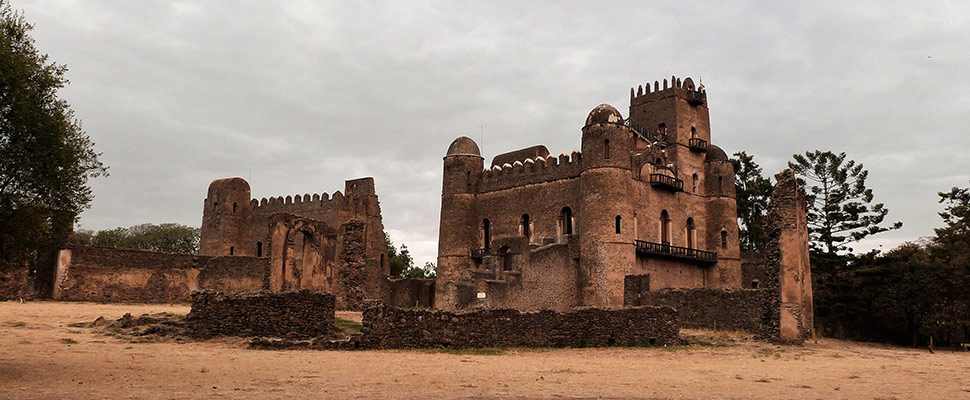
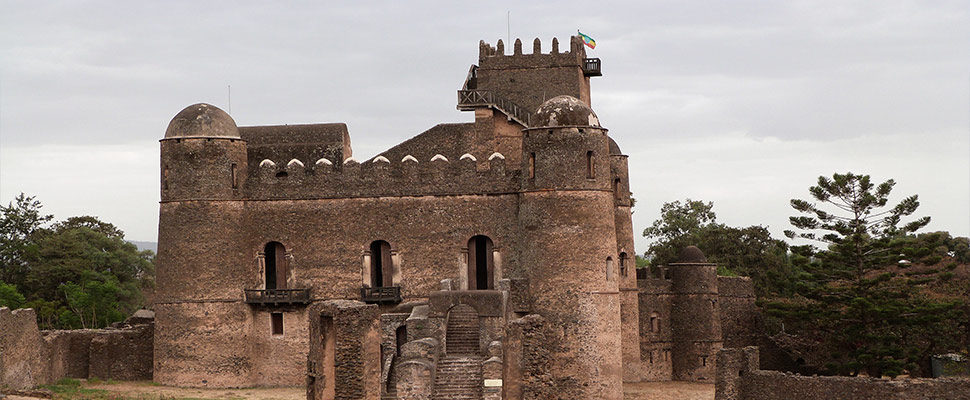
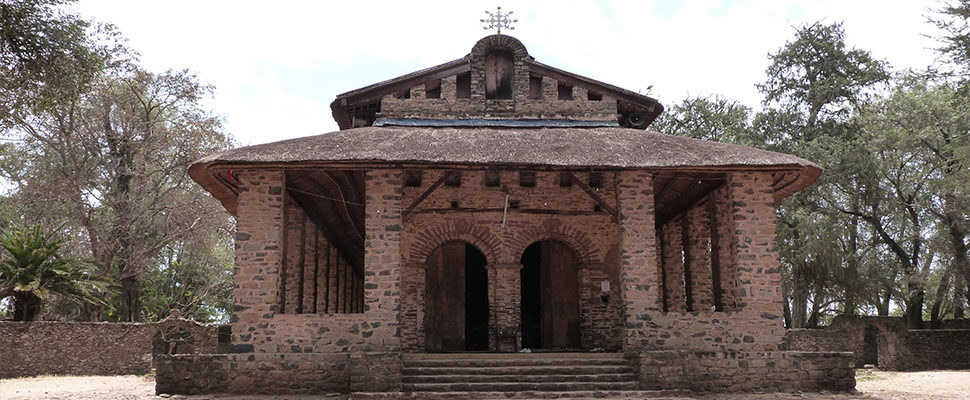
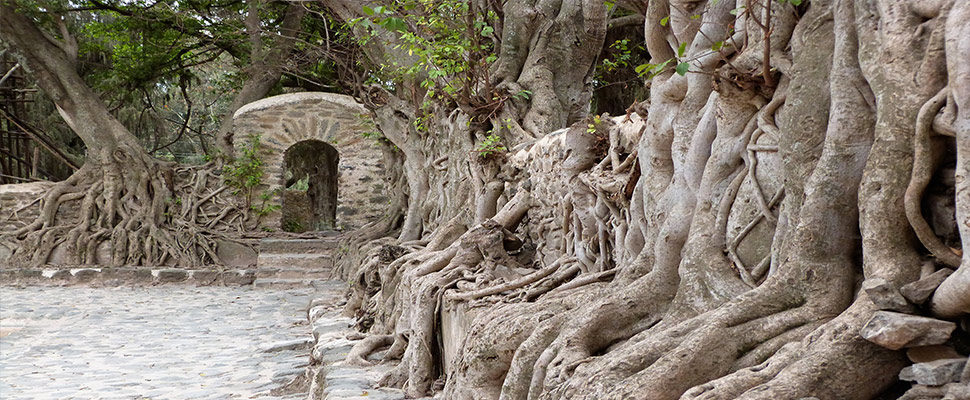
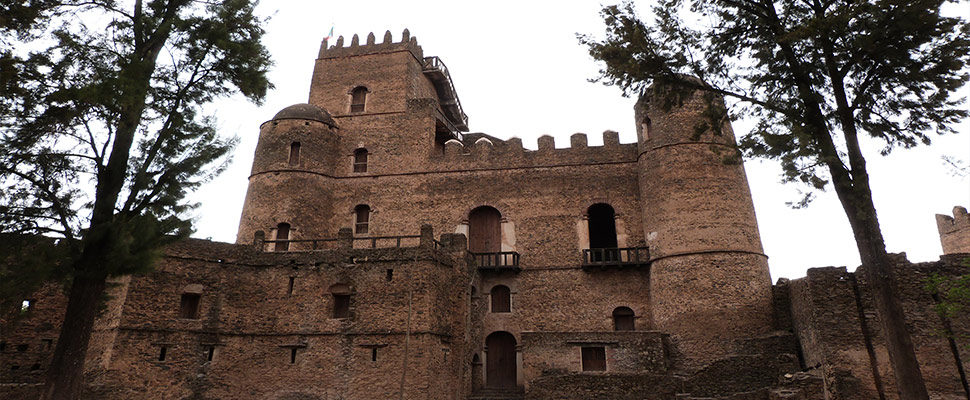


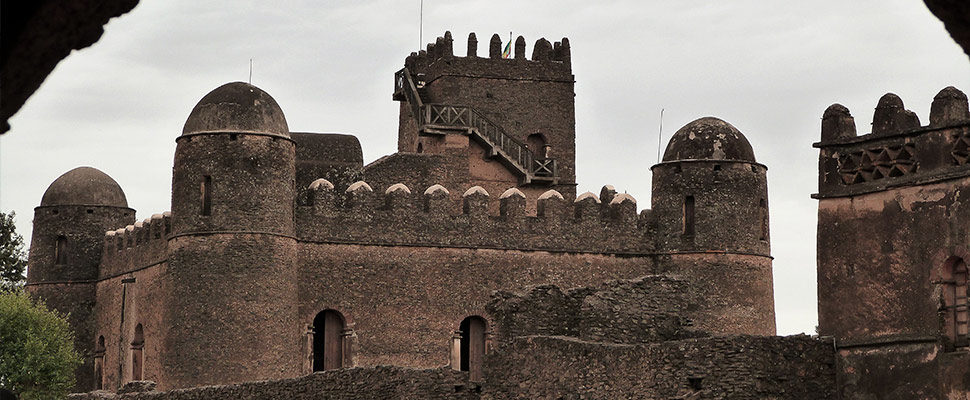
Gondar
Gondar became the capital of Ethiopia during the reign of Emperor Fasiladas (1632-1667), who built the first of the many castles to be found here. During this time, Gondar rose to prominence as Ethiopias largest permanently settled city. Gondar was a thriving centre of theology, trade, craftsmanship and the arts, and an sophisticated administrative and aristocratic centre. In the 19th Century, Emperor Tewodros II moved his government to Debre Tabor and then Mekdala, and Gondar became less important, eventually looted by the Sudanese Dervishes in the 1880s. The city contains some of Ethiopia’s most fascinating antiquitites.
Many structures can be found in the Imperial compound. The two-storeyed Palace of Emperor Fasiladas comprises a flat roofed structure, with four small round towers, a battlement parapet and a large tower, from which Lake Tana can be seen in the distance. Here, you can also find the Palace of Fasiladas’ son, Emperor Yohannes I (1667-1682), the Palace of Yohannes’ son, Emperor Iyasu I (1682-1706), the large hall of Emperor Dawit II (1716-1721) ,the banqueting hall of Emperor Bakaffa (1722-1730) and the palace of his Empress, Mentewab.
South of Gondar, you can find the bathing palace of Fasiladas, which is filled with water once a year for the Timkat (Epiphany) ceremony. To the North-West, are buildings belonging to the government of the time, most of which are now ruins. The largest of these is a three-storeyed castle, the battlement parapets embellished with bas reliefs of Ethiopian animals. There are also many churches here, including Debre Birhan Selassie, the roof of which is decorated with winged angels, and the walls with biblical depictions, including the crucifixion, and the legend of St George and the Dragon. The churches of Gondar contain ancient Gondarine manuscripts, and a crypt holds the skeletal remains of Empress Mentewab her son, Emperor Iyasu II, and her grandson Emperor Iyo’as.
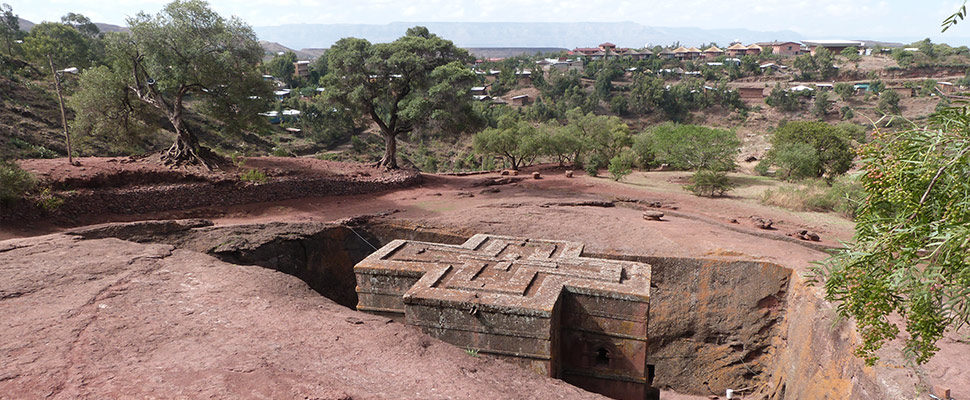
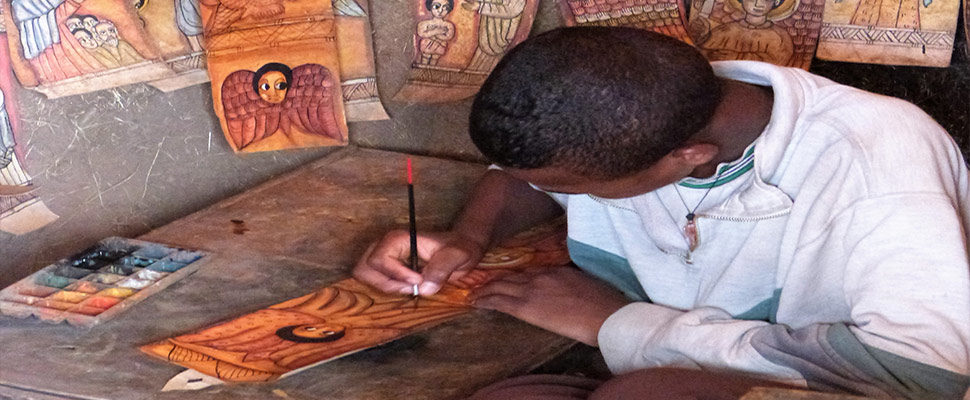
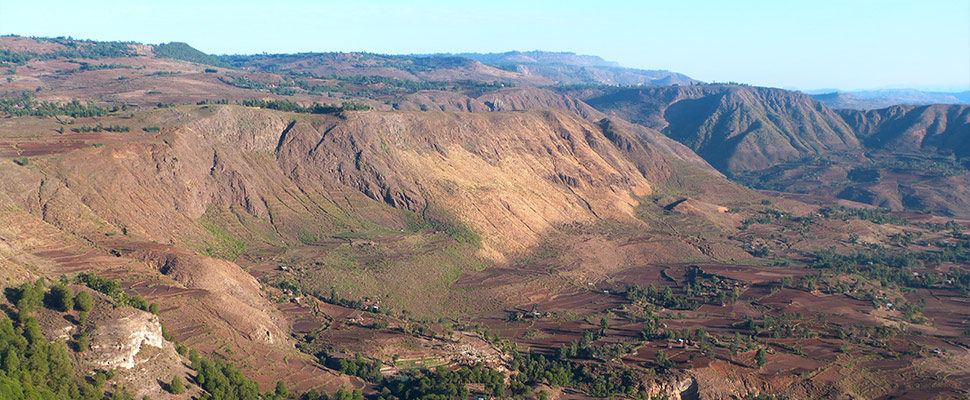
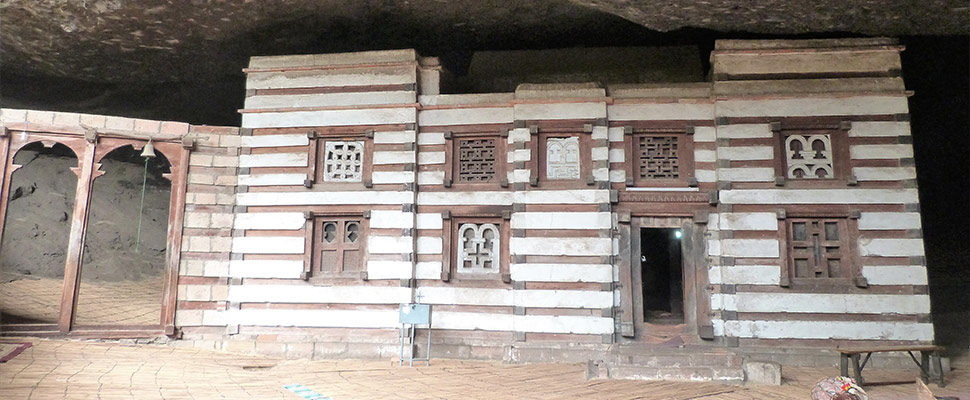
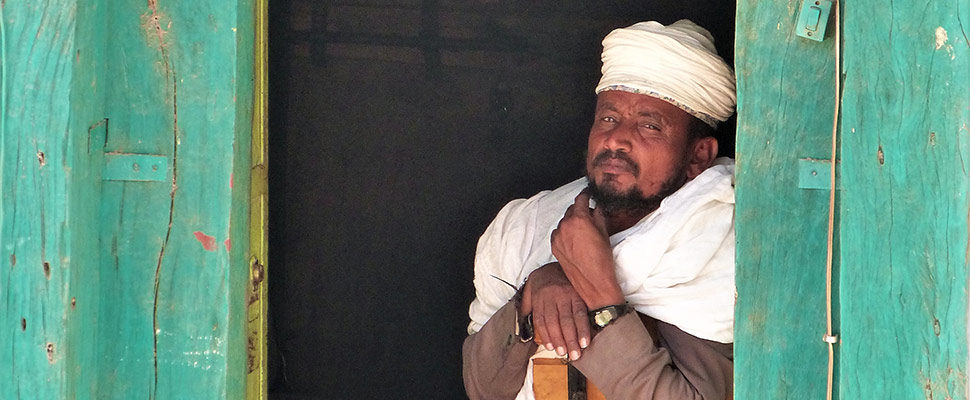
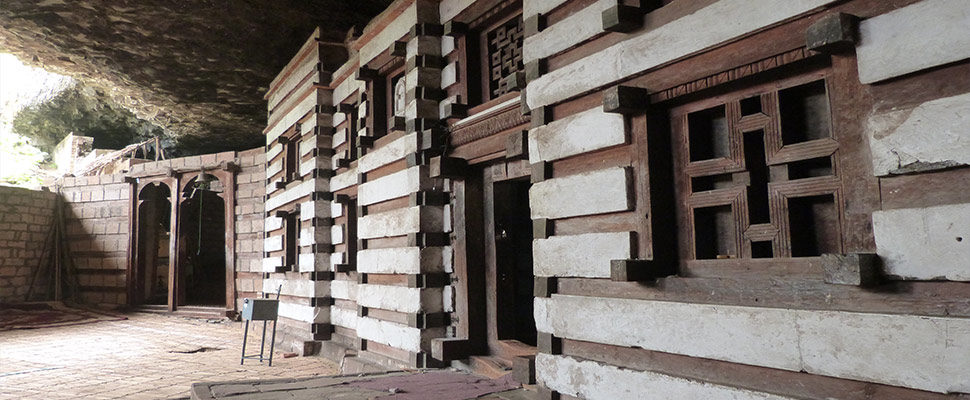
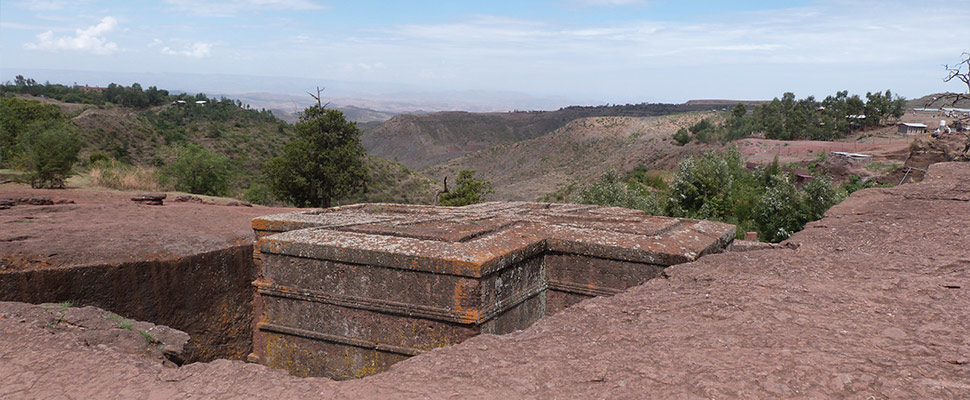

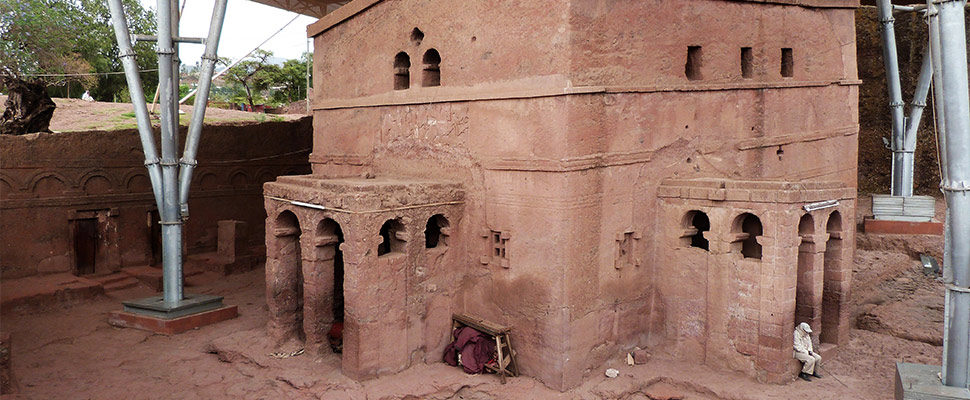

Lalibela
Lalibela, formerly called Roha, now carries the name of the 11th Century King Lalibela of the Zagwe Dynasty. Legend tells of rivalry between the young Prince Lalibela and his elder brother, King Harbay, following their mother’s revelation that Lalibela would be King. Harbay attempted to murder Lalibela with a poison which put Lalibela to sleep. During this sleep, Lalibela was taken to Heaven by angels, where God ordered him to build churches in Roha. Awakening from his sleep, and forgiving his brother, the two travelled to Roha, where Harbay abdicated to make way for Lalibela. On his coronation, Lalibela set about building the churches, the work being completed quickly because angels were said to continue the work at night.
The churches are carved from the rock they stand in, and many are comprised of labyrinthine tunnels and crypts connecting galleries and grottos. The largest church is Bet Medhane Alem, built almost like a Greek temple, surrounded by square columns, and a further set of columns supporting the roof inside. In one corner are three symbolic graves, dug for biblical patriachs Abraham, Issac and Jacob.
The two churches of Bet Golgotha and Bet Mika’el are complexly interlinked, and house the Selassie Chapel, and perhaps even the tomb of Lalibela himself. The churches also house some of the most beautiful processional crosses in Lalibela, one of the most elaborate and oldest of which is reputed to have belonged to Lalibela.
The elegant, Greek cross-shaped church of Bet Giyorgis is located in a deep pit with perpendicular walls, accessible only by a tunnel located a small distance away. This church was built by Lalibela for Saint George, who is said to have supervised its construction himself, and the monks will still show you the hoof marks left by his horse.
Where to stay
These are just a selection of the properties we can personally recommend. Please get in touch to hear more about our full portfolio.
Bale Mountain Lodge
Bale Mountain Lodge is an eleven room boutique forest wilderness lodge, deep within the Bale Mountain National Park (BMNP) of south central Ethiopia. The location of Bale Mountain Lodge was selected to provide an excellent opportunity for guests to experience a pristine wilderness environment.
Kuriftu Resort and Spa
Kuriftu Resort and Spa is located on the edge of Lake Tana, the perfect spot to sit back and relax after exploring all that Bahir Dar has to offer. Kuriftu’s 28 cottages are constructed of local stone and modestly decorated giving a spacious feel to the rooms.
Limalimo Lodge
Limalimo Lodge is a boutique 12 room lodge in Ethiopia’s stunning Simien Mountains National Park. Guests are able to explore the unique flora and fauna of the Simiens and visit local communities, or simply relax in the comfort of the lodge and its grounds.
GET IN TOUCH WITH US NOW TO START PLANNING YOUR JOURNEY
Follow Us
Proudly ASSOCIATED WITH











